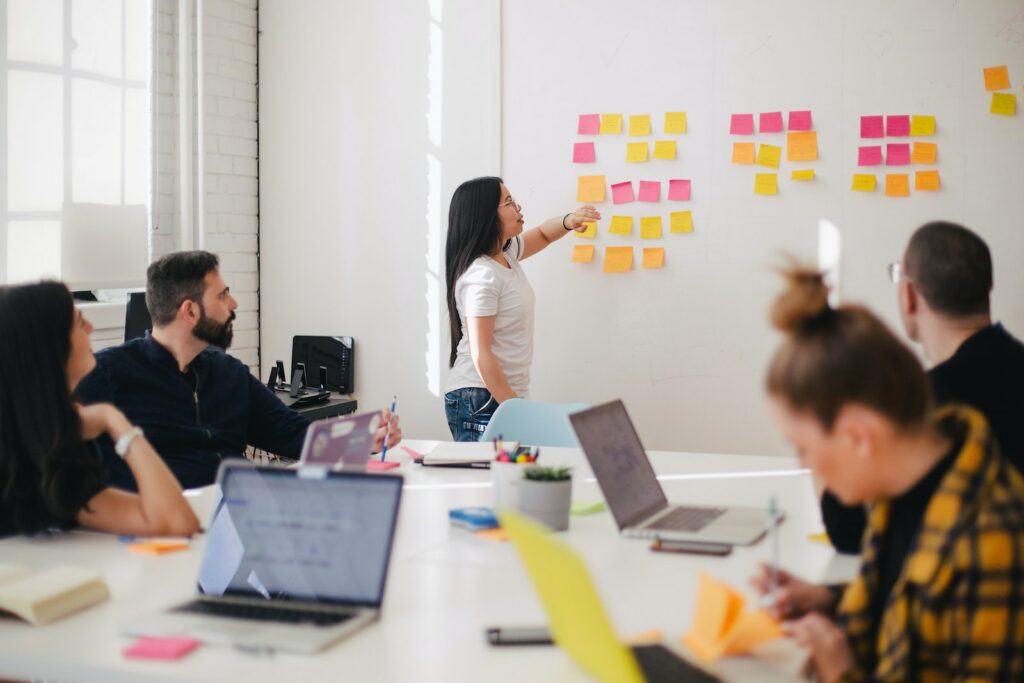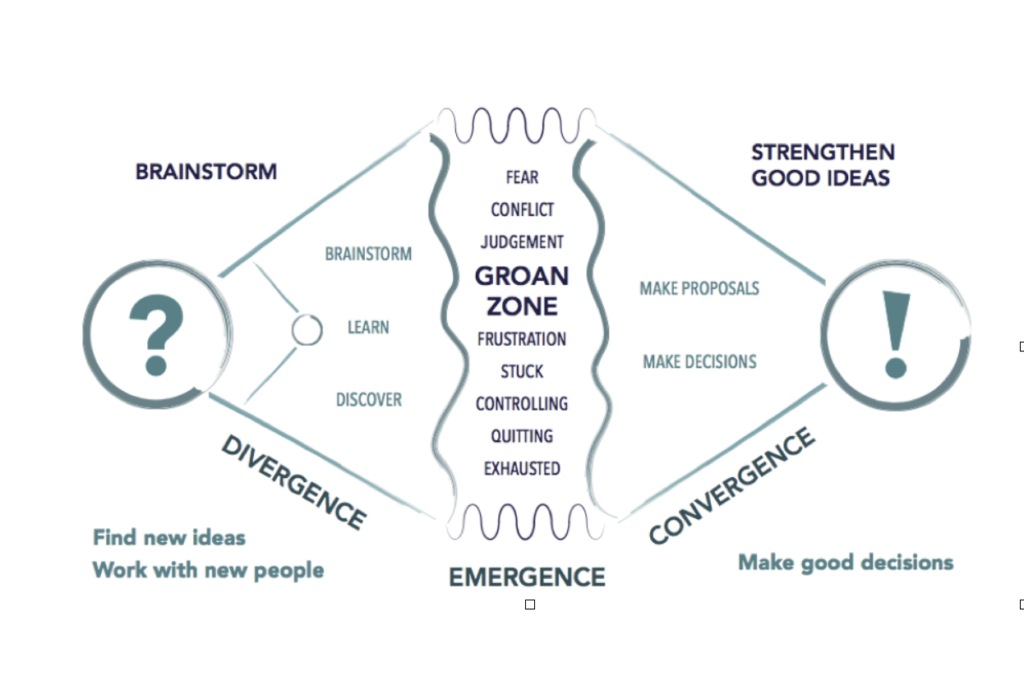
”Collaboration – for what? I can do this better on my own…” I think WHAT to learn and the PURPOSE drives the HOW to learn. In the learning process there must be different ways of learning – the content need to be prepared or to seek on my own, sometimes I need to discuss with others. Reading a book for instance… I can read it and reflect, but understand the content in a deeper way, get different perspectives and listen to a various experiences require other people. In a bigger context, I think collaboration in a various of ways support most learning outcome we seek for. Even if it is, like in leadership development, a more personal end result or outcome of learning: eg. how to lead others, organize for professional learning, use communicative strategies, cope group processes, develop cooperation processes, to lead school improvement, how to make decisions, take responsibility and handle legal issues. All of these – put in a reality – is better developed when working, exploring, practicing, together with others – even if some parts of it, the learner needs todo some work alone, reflect, write, present, etc. Although – in a world that is getting more complicated and complex, true solutions, innovations and learning is found ”in the bigger picture of our collective intelligence” (The Art of Hosting, 2017).

From ? to !
The Art of Hosting explains the process in three phases that involve to explore, co-create and innovate:
”In entering into an inquiry or multi-stakeholder conversation we operate with three different phases in the process – divergence, emergence, and convergence. Each of these phases is different and it is important for a host to know where we are in the process – and what is needed in each phase. The three phases of divergence, emergence and convergence are three different complementary ways of thinking and working. They can also be seen as the three phases of breathing: in-breath (lungs expanding/diverging); pause; out-breath (lungs contracting/converging). The “breath” of divergence and convergence—of breathing in and breathing out—is at the heart of designing process. Every process goes through several such breathing cycles.

The convergent phase is goal- oriented and focused, linear, structured and usually subject to time constraints. It is focused on getting results and may require quick decisions. Convergent thinking means evaluating alternatives, summarizing key points, sorting ideas into categories and arriving at general conclusions.
In the divergent phase, there is as yet no clear goal. This is a “goal-seeking” phase where a clear, shared purpose gives the collective direction. A key driver in this phase is asking the right questions. If you close the divergent phase too soon, the level of newness or innovation will be less. Ideally a group will stay in inquiry in the divergent phase until a new shared and agreed solution or goal is seen by everyone. Divergent thinking typically generates alternatives, has free-for-all open discussion, gathers diverse points of view and unpacks the problem. The divergent phase is non-linear and needs “chaos time.” It is process-oriented and needs prolonged decision time.
The emergent phase, between the divergent and convergent, is fondly known as the ‘groan zone.’ It is the phase where different ideas and needs are integrated. It may require us to stretch our own understanding to hold and include other points of view. We call it the groan zone because it may feel messy — an uncomfortable stretch — but it is also the phase where the new solution emerges” (The Art of Hosting Workbook, 2017).
All of this, in a co-creating process, also leave an individual harvest of learning and doing. To create such a learning opportunity described by AoH is much about mindset of both participant and facilitator – where the learning and doing is in focus. To sum up:
| DIVERGENT THINKING |
CONVERGENT THINKING |
| Generating |
Evaluating alternatives |
| Free-for-all open discussion |
Summarizing key points |
| Gathering diverse points of view |
Sorting ideas into categories |
| Unpacking the logic of a problem |
Arriving at general conclusions |
Learning that engage
Collaborative and co-creating ways of teaching and learning also makes the learning more engaged in participative activities, giving more time to student-student and student-teacher interactions. Principals for liberating structures are (https://www.liberatingstructures.com/principles):
- Include and Unleash Everyone
- Practice Deep Respect for People and Local Solutions
- Build Trust As You Go
- Learn by Failing Forward
- Practice Self-Discovery Within a Group
- Amplify Freedom AND Responsibility
- Emphasize Possibilities: Believe Before You See
- Invite Creative Destruction To Enable Innovation
- Engage In Seriously-Playful Curiosity
- Never Start Without Clear Purpose
The 10 principles in action:
In the link you will find more information:
https://static1.1.sqspcdn.com/static/f/1272828/26988242/1461347577013/Principles.pdf?token=5uE6EGn+3QbR2FEKqRxTZLVMznI=
- These principles can be used when designing a course, a specific class or why not your own lecture (to make the lecture more including, unleashing the students’ experiences and knowledge, create a clear purpose, stop and discover and to move forward).
- Make the learning open and end with both a collective harvest and an individual one. That is – what did we/I learn, what was the solution to our problem or the answers to our questions.
A practical example
From the ten principles, be sure of what the purpose is with the “lecture”, that you want to include and unleash the participants, have a deep respect of their own experiences, how you will provide or prepare input of knowledge or for the participants to seek for answers, etc.
- Invite – what are the key questions or topics to explore: Eg. Identify the problem/s. What are the relevant theories or principles? What opportunities do you see to move forward?
- Arrange the space and time: materials, groups, time, etc.
Below are some of liberating structures in practice http://www.liberatingstructures.com/ls-menu/
Myth turns:
What is a belief or an assumption that has shaped or guided you, but that you are starting to question, maybe a false notion or may be holding you back? Myth Turning can be helpful when searching for ways to come together again. It can also help with making sense of the problem you’re facing. Be aware of thoughts and views.
Crucial uncertainties:
Possible scenarios when things go right or wrong.
Nine whys:
Why is this problem relevant to you or to stakeholders?
Story:
Participants think of a situation…
Discover and dialogue:
How do you know when the problem is present?
How can you contribute to solving the problem?
What hinders you from acting?
Input and seek answers:
Could be that the teacher contributes with input or students, with guidance of the teacher, seek answers elsewhere.
What, So what, Now what:
Encourage sensemaking by exploring the challenge in a structured way with What, So What, Now What. Step 1: “What have you seen, heard or observed?”, “What did you notice? What facts stood out the most?”. Step 2: “So, what do these observations mean to you?”, “What seems to be important?”, “What patterns and conclusions are emerging?” Step 3: “Now what actions make sense? What is a good next step? Do this individual, pair and in the whore group as in 1-2-(4)-ALL…
The teacher’s or facilitator’s role
In these kind of learning- and collaborating practices, the teacher does not need to have all the knowledge or answers, but is more the ever before important for the learning and the learner. The teacher leverages on other people’s knowledge to solve problems and create new knowledge for everybody through collaborative learning (Margret Wheatley, AoH, 2017). The teacher must make the group task relevant for the learner and establish a healthy balance between structure (clarity of task) and learner autonomy (flexibility of task). The teacher must monitor group activities actively and closely.
Also, sometimes a teacher need to lecture – but not necessary in an old traditional way – even though that also has its values (mostly regarding the time frame – to present information quickly). The word lecture comes from a Latin word meaning ”to read”. It dates back to when it was difficult to print books. The only way to spread knowledge was to ”lecture” – to read to others. This form of teaching is still common, but not always so effective.
Instead, the teachers role should instead be to ask questions and let people together find the answers with of course guidance by the teacher (http://americanradioworks.publicradio.org/features/tomorrows-college/lectures/transcript.html).
But when the learners don’t have enough knowledge to know what to look for and asess what’s important? Of course the teacher can’t leave students alone. The main point is to make the learner more active in the learning process. One way is the so-called flipped classroom, where students come prepared and the ”lecture” is replaced with asking questions, finding out answers together, conversations, etc. http://americanradioworks.publicradio.org/features/tomorrows-college/lectures/. But there are other ways to make a lecture more interactive. Jennifer Gonzalez pod ”Cult of pedagogy” gives a few pwerspectives on lectures and how to make them better by using lectures with intention https://www.cultofpedagogy.com/better-lecture/ (listen to the the pod – or read it).
However – people usually go down the easiest road. People take mental shortcuts to avoid thinking (Katz & Ain Dack, 2017). So the teacher needs to address barriers that hinders learning and students need to understand the learning process. Here is also an important issue to adress as a teacher – eg. rules and online culture, how to build a community, how the students can succeed in the learning, support in how to learn, follow up, be present (Kay, 2022).
Frustration in collaboration on-line
A study focusing on online learning frustration showed that the perception of an asymmetric collaboration among the teammates was identified by the students as the most important source of frustration (Capdeferro & Romero, 2012). Online learners also identified difficulties related to ”group organization, the lack of shared goals among the team members, the imbalance in the level of commitment and quality of the individual contributions, the excess time spent on the online tasks, the imbalance between the individual and collective grades, and difficulties in communication, among other factors leading to frustration” (Capdeferro & Romero, 2012). They suggest that institutions may supply learning environments that facilitate social interaction and collaboration and assure effective support to students with technological difficulties.
Following aspects are a few on what a teacher could take responsibility for and know how to do:
- Be a learner designer and somewhat a technology specialist
- Sharing knowledge regarding to the learning purpose
- Instruct, guide and be a part of answering questions about the learning process
- Be a content coach
- Awakening students´ interest – be a motivator and a role model
- Be a co-learner and effective communicator also about social issues
- Also be good at managing correspondents with students
This might also be summarized in that a teacher takes a cognitive role, affective role and a managerial role, meaning to communicate, give feedback, be a guide to learning and also to give some boundaries (Huang, 2018).
The nest question is to go from the frame and method to make it work also in an on-line environment. That is the focus on Topic 4.
References

Art of Hosting. https://artofhosting.org/
Capdeferro, N. & Romero, M. (2012). Are online learners frustrated with collaborative learning experiences?. The International review of research in open and distance learning, 13(2), 26-44.
Gonzales, Jennifer. Cult of Pedagogy. https://www.cultofpedagogy.com/
Fink, D and Ganus, M. ‘Designing Significant Learning Experiences’. https://cpb-use1.wpmucdn.com/sites.uw.edu/dist/9/92/files/2019/06/AAG_AspiringAcademics.pdf#page=97
Huang, Q. (2018). Examining Teachers’ Roles in Online Learning. The EUROCALL Review,Volume 26, No. 2, September 2018.
Katz, S. & Ain Dack, L. (2013). Intentional interruption. Breaking down learning barriers to transform professional practice. Corwin Press.
Kay, Robin. Thriving Online in Higher Education. (seminar in ONL222, 2022-11-22).
Liberating structures – For 30+ more examples: https://www.liberatingstructures.com/ls-menu/ (see Appendix)
Wheatley, Margreth (in The Art of Hosting Workbook, 2017)
Other resources:
http://americanradioworks.publicradio.org/features/tomorrows-college/lectures/transcript.html